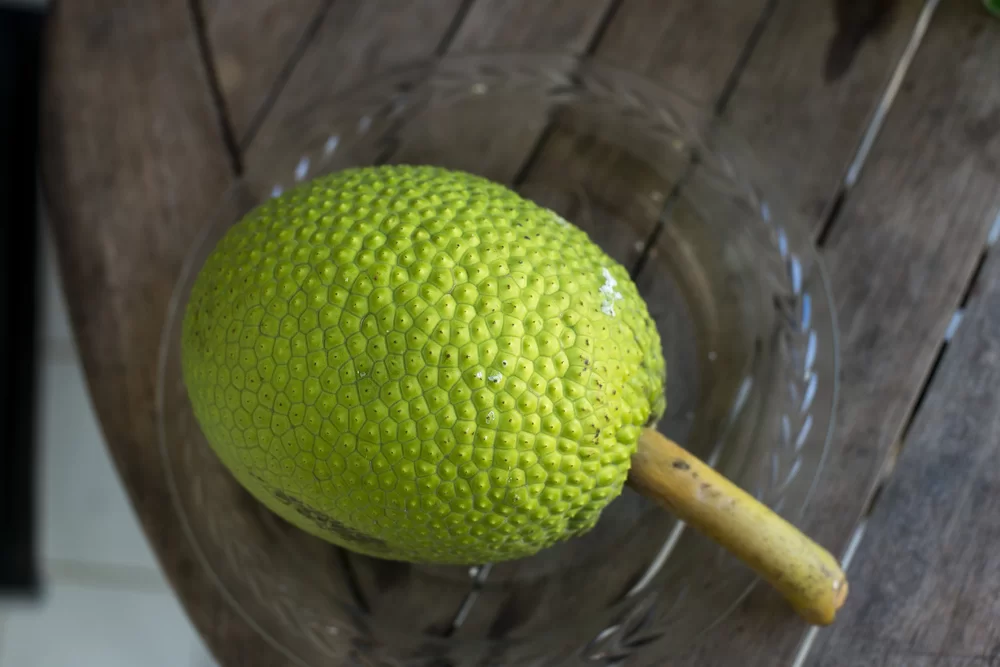
Caribbean Fruits: Quick Facts about Breadfruit & Why It Is Good for You!
Living in the tropics allows us to enjoy many vegetables, fruits, herbs, and spices that transform our meals. Our dishes are infused with local ingredients used in different ways to enhance taste, meal presentation and flavour.
Some of us use rice, flour, vegetables, or pasta dishes to accompany our favourite protein. However, there is a popular fruit that Caribbean people also enjoy eating – breadfruit.
Breadfruit (Artocarpus altilis) is enjoyed in different ways across the Caribbean. It can be added to soups, salads, used in tacos, or enjoyed as chips.
Fried breadfruit is a favourite in Guyana and can be enjoyed with salt-fish or fish curry. Breadfruit is also a major part of the national dish for St Kitts and Nevis. In Jamaica, roast, baked, boiled, and fried breadfruit are popular. Breadfruit pie, fried breadfruit, pickled breadfruit, and breadfruit cou cou are some of the ways it’s enjoyed in Barbados. Trinbagonians use it as a key ingredient in “oil down”.
Quick facts about breadfruit
- Breadfruit can be grounded into flour to be used as a gluten-free option for pastries, bread, and desserts.
- The trees require little to no maintenance, and they can grow under most soil conditions.
- A breadfruit tree may start to bear fruit in three to five years.
- One tree can produce up to 200 pounds per yield two or three times per year.
- Breadfruit contains approximately 4.0 grams of fibre, making it one of the highest fibre-rich fruits. Dietary fibre can help with constipation and lower cholesterol, among other benefits.
- It’s a good source of antioxidants, calcium, copper, dietary fibre, iron, magnesium, niacin, potassium, protein, thiamine, vitamin C and other nutrients.
- Breadfruit contains omega-3 and omega-6 fatty acids that help to promote bone health, stimulate hair and skin growth, and regulate metabolism.
- Breadfruit is gluten-free, making it a great alternative for people with celiac disease or non-celiac gluten sensitivity.
- The trees are resilient to droughts, floods, and high winds and can remain productive for decades.
- Breadfruit trees provide shelter for food to bats, honeybees, and birds, which are important seed dispersers and plant pollinators.
- Fibres from the bark of the tree can be used to make clothing, latex (glue, chewing gum, etc.), paper, mosquito nets, accessories, and artwork.
- Breadfruit leaves and fallen fruits can be used as animal feed.
- The flower from the male breadfruit is very effective at repelling mosquitoes and other insects.
- As a perennial, breadfruit trees have an estimated lifespan of 50 or more years.
- The wood of the breadfruit tree is light, durable and resists termites and marine worms, making it useful for the construction of houses and canoes.
Important: Breadfruit belongs to the Moraceae or mulberry family of plants (fig) so, if you’ve had an allergic reaction to jackfruit, it is possible you could feel similar side effects from eating breadfruit (more research is needed).
We hope you enjoyed reading about breadfruit and the possible health benefits and side effects.
The content in this article is for informational purposes. Always consult with and follow the recommendations of your doctor for health-related issues. To find a doctor near you, search our Find Yello listings.
Sources: Global Breadfruit, NTBG, VeryWell, Med India, Eat Breadfruit, and Forbes.
By Carolyn Lee
Carolyn Lee is a writer for Yello Media Group.